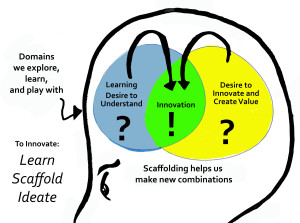Innovation is Learning
For many years I kept the concepts of innovation and learning in separate boxes. I thought innovation was creating new things of value, and, learning was understanding new things. I always suspected there was a closer connection.
I now believe that learning and innovation are joined at the hip. You can’t innovate without an exploratory learning process. It’s a two circle Venn diagram with a large intersection set. Deliberately embracing learning — as part of the innovation process — can lead to better ideas and improved innovation results.
It may seem like an obvious connection, but when I made the “innovation is learning” statement at a recent presentation — thinking everyone would agree — I got a room full of raised eyebrows. So, let me explain my thinking.
Domain Knowledge is an Innovation Pre-requisite
To start the innovation process you have a question in mind, and it might be quite vague. That’s where you start thinking about what you might do, or change, in some area of expertise or knowledge. Generally, you need knowledge of a domain before you can invent within it. There are exceptions — sometimes ignorance helps you stumble into something those in an expertise area don’t see. But, for the most part it’s difficult to create something truly novel and useful if you don’t understand the situation, context, market, area, the domain.
Acquiring the knowledge necessary to innovate within a domain means learning. Some would call this market research, and by all means do that, but I think it goes deeper. Sometimes, finding out new information, through exploration and experimentation leads rapidly to innovation.
Knowledge Across Many Domains Is An Innovation Accelerator
Speaking of learning, it’s helpful to have knowledge across many domains. Acquiring knowledge across many domains is about broad-based learning, and it’s often where big “I” innovation comes from.This allows creative combinations of ideas and concepts from one area — with ideas or concepts from another. Inventions and ideas are, essentially, new combinations of existing concepts. The printing press combined a wine press with the concept of movable type. One domain is agriculture; the other is communications. This type of combination is known as a “concept blend.”
Pick Up the Bongos and Play
Wide learning opens the door to making connections others don’t yet see. One of the reasons daVinci, Einstein, Elon Musk, and other famous thinkers come up with such amazing things is they have knowledge spread over multiple domain s. Inventors and scientists are often secret general knowledge freaks; it’s their curiosity. Richard Feynman, the famous physicist, spent a great deal of time in Brazil learning the bongos, and, he dabbled in safe-cracking. Feynman read an encyclopedia “to relax.” He continually made the point that when he stopped having fun with ideas just for the sake of having fun – he lost his edge.
s. Inventors and scientists are often secret general knowledge freaks; it’s their curiosity. Richard Feynman, the famous physicist, spent a great deal of time in Brazil learning the bongos, and, he dabbled in safe-cracking. Feynman read an encyclopedia “to relax.” He continually made the point that when he stopped having fun with ideas just for the sake of having fun – he lost his edge.
If you want to be a more effective innovator, become more curious, about everything, and play with the concepts.
Concept Blends Require Scaffolding
Making new connections across domains is not that easy, and yet, that’s where fresh ideas, brand new concepts, come from. Imagination is aided when you help your mind connect the remote dots and data points.
Let me introduce you to scaffolding. I heard the term from a friend and colleague many years ago and at first only thought it was her lingo for describing “helping” others. I discovered that the concept is actually a well-defined educational term. To scaffold means to provide successive levels of temporary support, helping a student learn something new. To some extent, many teachers provide scaffolding. I recall a geometry teacher I had in high school that was amazing at leading you towards learning. Fr. Mueller provided simple steps and examples building towards the complex. He drew analogies to shooting pool and his drawings of a pool shot illustrating angles of reflection and deflection had me learning that concept quickly. There was a technical element to his scaffolding, a visual element, and a fun element; they collectively helped me learn.
Facilitators who scaffold well are master innovation facilitators and their projects achieve better results. In general, the more “modalities” you touch, visual, auditory, textual, kinesthetic, and emotional experiences — the better your scaffolding. See Sunni Brown’s Ted talk for more on this “multi-mode” approach to scaffolding.
Guess what? We can all become better at scaffolding, which will help us learn, help others learn, and help us innovate. The key is to get creative with how your organize your innovation projects. Learning and exploration come first, then interactive exercises and tasks that have people playing with the data points, leading to concept blends and brilliant, new, fresh ideas.
How Scaffolding Applies to Innovation
Coming up with new ideas is part of any innovation process or framework. To scaffold thinking, participants should explore the domain first, and related domains, before group ideation. This might include market research, observation, interviews, and more. This might include brainstorming alone, prior to a group session.
Exploration (learning) isn’t lost on the Design Thinking framework, which emphasizes user empathy. Empathy is great, because that immersion into a user’s thinking — scaffolds your thinking towards ideation. Exploration might also include exploration into domains that have solved similar problems or faced similar challenges (this is essentially what the TRIZ framework is all about). It brings the mind to a place where a new connection can be made. Another thing is going on when you explore. As you think about a challenge and collecting information, you’re subconsciously building potential ideas. This is a phenomena called “incubation.” Doing exploration is scaffolding your mind into more productive incubation. Eventually that egg hatches into an innovative idea.
But wait, there’s more.
Innovation sessions are screaming for more scaffolding, prior to, and during, the session. It’s probably better to think of it as a mini-project that takes place over a few weeks, than a classic session.
How might you do more Scaffolding? Any exercise or game that explores and produces more data points, across more domains, in multiple modalities of learning. This done before ideation. Think activities like Mind Mapping, Improvisation Games, and other highly interactive exercises.
Learning and innovation are intertwined. To innovate: learn, scaffold, ideate.


